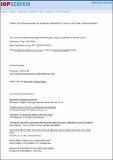| dc.contributor.author | Keathley, Phillip Donald | |
| dc.contributor.author | Bhardwaj, Siddharth | |
| dc.contributor.author | Laurent, Guillaume | |
| dc.contributor.author | Moses, Jeffrey A. | |
| dc.contributor.author | Kaertner, Franz X | |
| dc.date.accessioned | 2016-10-28T18:34:10Z | |
| dc.date.available | 2016-10-28T18:34:10Z | |
| dc.date.issued | 2016-07 | |
| dc.date.submitted | 2016-05 | |
| dc.identifier.issn | 1367-2630 | |
| dc.identifier.uri | http://hdl.handle.net/1721.1/105139 | |
| dc.description.abstract | An algorithm for characterizing attosecond extreme ultraviolet pulses that is not bandwidth-limited, requires no interpolation of the experimental data, and makes no approximations beyond the strong-field approximation is introduced. This approach fully incorporates the dipole transition matrix element into the retrieval process. Unlike attosecond retrieval methods such as phase retrieval by omega oscillation filtering (PROOF), or improved PROOF, it simultaneously retrieves both the attosecond and infrared (IR) pulses, without placing fundamental restrictions on the IR pulse duration, intensity or bandwidth. The new algorithm is validated both numerically and experimentally, and is also found to have practical advantages. These include an increased robustness to noise, and relaxed requirements for the size of the experimental dataset and the intensity of the streaking pulse. | en_US |
| dc.description.sponsorship | United States. Air Force Office of Scientific Research (grant FA9550-12-1-0080) | en_US |
| dc.description.sponsorship | United States. Air Force Office of Scientific Research (grant FA9550-12-1-0499) | en_US |
| dc.description.sponsorship | Center for Free-Electron Laser Science | en_US |
| dc.description.sponsorship | German Science Foundation. Hamburg Centre for Ultrafast Imaging-Structure, Dynamics and Control of Matter at the Atromic Scale | en_US |
| dc.description.sponsorship | United States. Department of Defense (National Defense Science & Engineering Graduate Fellowship (NDSEG) Program) | en_US |
| dc.language.iso | en_US | |
| dc.publisher | IOP Publishing | en_US |
| dc.relation.isversionof | http://dx.doi.org/10.1088/1367-2630/18/7/073009 | en_US |
| dc.rights | Creative Commons Attribution 3.0 Unported licence | en_US |
| dc.rights.uri | http://creativecommons.org/licenses/by/3.0/ | en_US |
| dc.source | IOP Publishing | en_US |
| dc.title | Volkov transform generalized projection algorithm for attosecond pulse characterization | en_US |
| dc.type | Article | en_US |
| dc.identifier.citation | Keathley, P. D., S. Bhardwaj, J. Moses, G. Laurent, and F. X. Kärtner. “Volkov Transform Generalized Projection Algorithm for Attosecond Pulse Characterization.” New J. Phys. vol. 18, no. 7, 073009, July 2016, pp. 1-15. | en_US |
| dc.contributor.department | Massachusetts Institute of Technology. Department of Electrical Engineering and Computer Science | en_US |
| dc.contributor.department | Massachusetts Institute of Technology. Research Laboratory of Electronics | en_US |
| dc.contributor.mitauthor | Keathley, Phillip Donald | |
| dc.contributor.mitauthor | Bhardwaj, Siddharth | |
| dc.contributor.mitauthor | Laurent, Guillaume | |
| dc.contributor.mitauthor | Moses, Jeffrey A. | |
| dc.contributor.mitauthor | Kaertner, Franz X | |
| dc.relation.journal | New Journal of Physics | en_US |
| dc.eprint.version | Final published version | en_US |
| dc.type.uri | http://purl.org/eprint/type/JournalArticle | en_US |
| eprint.status | http://purl.org/eprint/status/PeerReviewed | en_US |
| dspace.orderedauthors | Keathley, P. D.; Bhardwaj, S.; Moses, J.; Laurent, G.; Kärtner, F. X. | en_US |
| dspace.embargo.terms | N | en_US |
| dc.identifier.orcid | https://orcid.org/0000-0003-1325-1768 | |
| dc.identifier.orcid | https://orcid.org/0000-0002-8127-5326 | |
| dc.identifier.orcid | https://orcid.org/0000-0002-6465-9360 | |
| dc.identifier.orcid | https://orcid.org/0000-0002-8733-2555 | |
| mit.license | PUBLISHER_CC | en_US |
